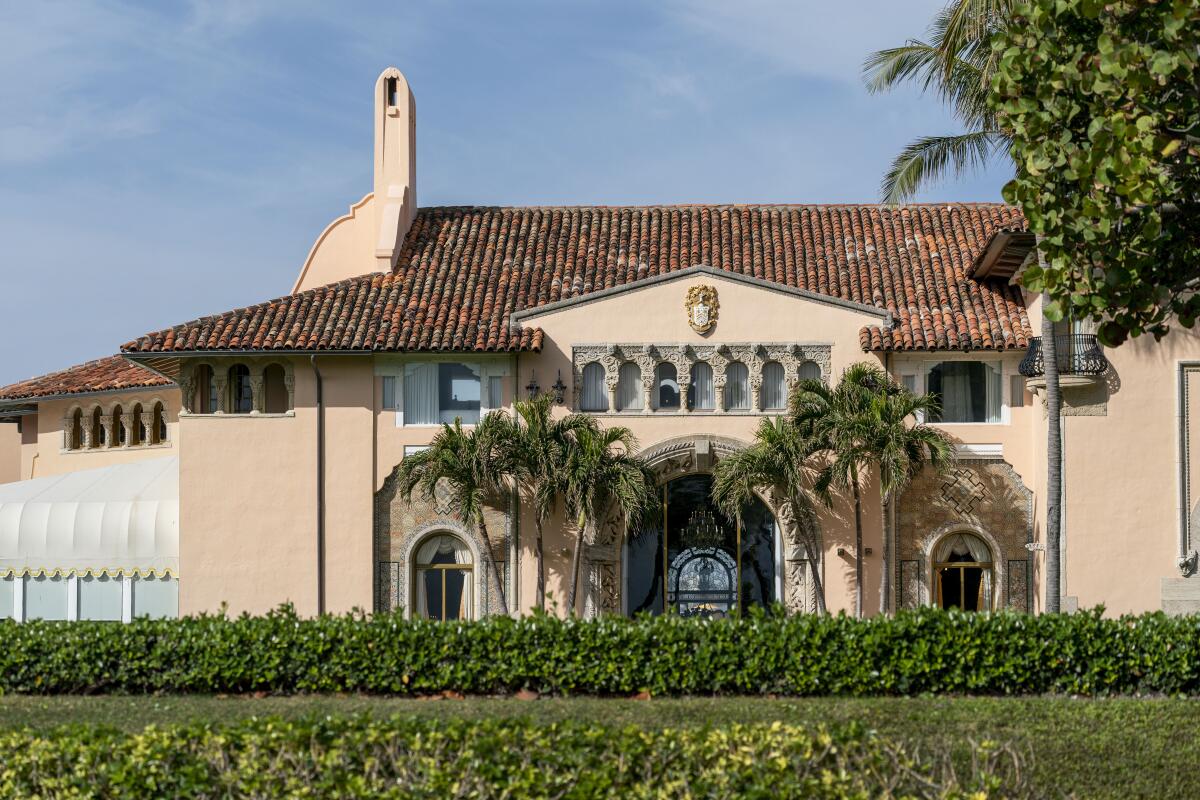Trump at Mar-a-Lago? Palm Beach says it has other issues to consider like falling coconuts

- Share via
FORT LAUDERDALE, Fla. — The Palm Beach Town Council spent close to seven hours Tuesday considering issues important to the wealthy island community: the availability of the COVID-19 vaccine. Revitalizing the downtown’s upscale shopping district. Even the durability of Belgian tile being used on a new walking path and the danger posed by coconuts falling when palm trees get too tall.
Each agenda item provoked a litany of questions, comments and observations, except one: whether former President Trump may continue living at his Mar-a-Lago Club. Though presumably the most contentious among residents and of the most interest nationally and internationally, the issue took up no more than a half-hour of the council’s time — at the meeting’s end.
The five-member council took no action on the question, which was placed on the agenda because of neighbors’ complaints that Trump’s presence would hurt property values. It’s unclear if the council will address the issue further, although an attorney representing the residents asked — with no response — that he be allowed to give a fuller presentation in April. The neighbors could also sue the town and Mar-a-Lago. Meanwhile, 990 miles to the north, the U.S. Senate began Trump’s second impeachment trial.
Town attorney Skip Randolph said there is nothing in the club’s 1993 agreement with Palm Beach that prohibits Trump from residing there.
“This is a debate that I really think is silly,” Randolph said. He and Trump attorney John Marion said the town permits clubs and resorts to provide onsite housing for their employees and Trump, as Mar-a-Lago’s president, fits the bill.
But attorney Philip Johnston, who said he represents a group of residents called Preserve Palm Beach, said neighbors of the club fear Trump’s residency will turn Mar-a-Lago into “a permanent beacon for his more rabid, lawless supporters,” destroying the town’s “genteel” character.
Residents have also previously argued that when he got permission to turn the 126-room mansion into a club 28 years ago, Trump promised through an attorney that he would not live at Mar-a-Lago. But Marion said that provision was left out of the final written agreement in exchange for Trump’s pledge to be financially responsible for preserving the property if the club fails.
Marion and Randolph both argued that because Trump is a Mar-a-Lago employee, he is not covered by a provision of the agreement that restricts members to stays of no more than seven consecutive days and 21 days per year. Marion said Trump has been performing numerous duties since resuming his title as club president on Jan. 25. That was five days after he returned to the 17-acre property, where he waved to cheering fans from his armored SUV 30 minutes before his term expired.
Trump’s duties include overseeing the staff, suggesting improvements, greeting guests, and recruiting and approving new members, Marion said.
“There is no reason in the world that this body should ever determine that former President Trump shouldn’t reside at the club he owns,” Marion said. “He loves it there.”
Marion also threw out a seemingly friendly warning to the protesting neighbors: Be careful what you wish for. If by “the slightest” chance Trump gets booted from Mar-a-Lago, Marion said, he would likely move into one of the other nearby homes he owns. The Secret Service bubble that now resides behind Mar-a-Lago’s gates would be on their street, he said.
“There would be barriers in front of that property. There would be guards and Secret Service personnel. ... There would be dogs sniffing vehicles,” Marion said. “It would be a horrible imposition for them [the neighbors] if they got what they wanted.”
But the neighbors, at least according to their attorneys, are willing to take that chance.
Preserve Palm Beach attorney Johnston warned that if Mar-a-Lago can offer residence to its employees, there is nothing to prevent Trump from circumventing the restrictions on members’ stays by making them all corporate officers.
“Does the council want Mar-a-Lago to be a multifamily residence?” Johnston asked.
After the 20-minute presentation, only two council members briefly spoke. One had a clarifying question for Marion, while Council President Margaret Zeidman said she agreed that Trump should be allowed to stay.
Trump purchased Mar-a-Lago for $10 million in 1985 from the estate of Marjorie Merriweather Post, the owner of General Foods. The 126-room mansion had deteriorated after her death in 1973, when she left it to the U.S. government as a possible presidential vacation home. The government gave it back in 1981.
After Trump bought it, he spent millions upgrading the property while living there part time.
By the early 1990s, however, Trump was in financial distress. Real estate prices dropped and several of his businesses flopped, including a New Jersey casino. He told the town that he could no longer afford the then-$3-million annual upkeep and it was unfair that he shouldered the costs alone. He proposed subdividing the property and building mansions. The town rejected the proposal.
In 1993, Trump and the town agreed he could turn the estate into a private club. It would be limited to 500 members — the initiation fee is now $200,000, and annual dues are $14,000.
More to Read
Sign up for Essential California
The most important California stories and recommendations in your inbox every morning.
You may occasionally receive promotional content from the Los Angeles Times.










